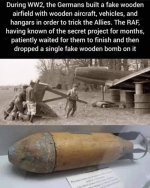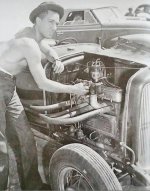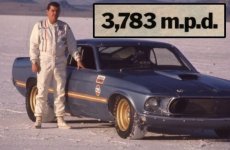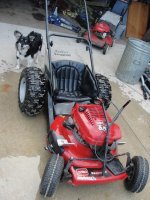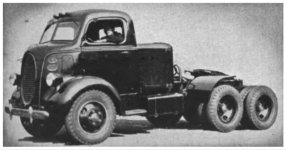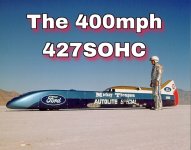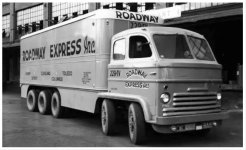Navigation
Install the app
How to install the app on iOS
Follow along with the video below to see how to install our site as a web app on your home screen.

Note: This feature currently requires accessing the site using the built-in Safari browser.
More options
You are using an out of date browser. It may not display this or other websites correctly.
You should upgrade or use an alternative browser.
You should upgrade or use an alternative browser.
Did You Know?
- Thread starter 351CFalcon
- Start date
3,783 m.p.d.
Mickey Thompson put his boot in it at Bonneville in September 1968 and blasted his Class C 1969 Mustang Mach1 to a new world record: 3,783 miles in a day.
He beat the old 24-hour record by 405 miles. His average was 157.633 m.p.h.--a big 17 m.p.h. faster.
He smashed 295 other records along the way.
It needs to be noted that Mickey took three Mustangs with him to Bonneville, a blue, yellow and red Mach1.
Although the blue Mach1 is shown below, it was the yellow one that set the record.
The driving chores were shared with Danny Ongais and Hot Rod editor Ray Brock.
click to enlarge
Mickey Thompson put his boot in it at Bonneville in September 1968 and blasted his Class C 1969 Mustang Mach1 to a new world record: 3,783 miles in a day.
He beat the old 24-hour record by 405 miles. His average was 157.633 m.p.h.--a big 17 m.p.h. faster.
He smashed 295 other records along the way.
It needs to be noted that Mickey took three Mustangs with him to Bonneville, a blue, yellow and red Mach1.
Although the blue Mach1 is shown below, it was the yellow one that set the record.
The driving chores were shared with Danny Ongais and Hot Rod editor Ray Brock.
click to enlarge
Attachments
428 Fuel Injection Mustang
According to Kar Kraft paperwork, a fuel Injected 428 Mustang was built, presumably at Shelby.
Roy Lunn (Vice President of Kar Kraft) found a mechanical fuel-injection system in England and decided to try developing it, possibly for production. The company Tecalemit Jackson, sent a kit to Kar-Kraft for installation on a Mustang.
They also sent a designer to help work out the on-car packaging and to consult on the installation and tuning.
The packaging (location of components, wiring, fuel lines, etc.) turned out to be terrible.
The system did not perform any better, either.
The results were a sore spot for Lunn. he canceled the project and sent the designer back to England.
Ford had to wait a long time for fuel-injection systems suited to production lines and vehicle operation.
This fuel injection system was developed in England in the 1960's, primarily aimed at road racing, as opposed to Hilborn/Algon which was more for drag racing.
Tecalemit-Jackson apparently had a better partial throttle metering system for road racing, but because it was a continuous flow/low pressure, it didn't develop the max power as good as the Lucas - high pressure sequential fuel injection system that had better fuel atomization, more power.
None the less, it still was used, and tested in GT40's.
Holman-Moody was the US distributor.
The throttle bodies were based off of the weber 48 IDA, and could be bolted on any weber 48IDA intake, each throttle body separately.
The lower intake pictured is a Holman Moody Marine unit.
The Conelec fuel injection system was used on a few 1968 Shelbys.
click to enlarge
According to Kar Kraft paperwork, a fuel Injected 428 Mustang was built, presumably at Shelby.
Roy Lunn (Vice President of Kar Kraft) found a mechanical fuel-injection system in England and decided to try developing it, possibly for production. The company Tecalemit Jackson, sent a kit to Kar-Kraft for installation on a Mustang.
They also sent a designer to help work out the on-car packaging and to consult on the installation and tuning.
The packaging (location of components, wiring, fuel lines, etc.) turned out to be terrible.
The system did not perform any better, either.
The results were a sore spot for Lunn. he canceled the project and sent the designer back to England.
Ford had to wait a long time for fuel-injection systems suited to production lines and vehicle operation.
This fuel injection system was developed in England in the 1960's, primarily aimed at road racing, as opposed to Hilborn/Algon which was more for drag racing.
Tecalemit-Jackson apparently had a better partial throttle metering system for road racing, but because it was a continuous flow/low pressure, it didn't develop the max power as good as the Lucas - high pressure sequential fuel injection system that had better fuel atomization, more power.
None the less, it still was used, and tested in GT40's.
Holman-Moody was the US distributor.
The throttle bodies were based off of the weber 48 IDA, and could be bolted on any weber 48IDA intake, each throttle body separately.
The lower intake pictured is a Holman Moody Marine unit.
The Conelec fuel injection system was used on a few 1968 Shelbys.
click to enlarge
Attachments
Drag racing lawn mowers on ice .
What's the smallest and lightest mower?
A mower with a rear bagger on it.
Comet clutch and a torque converter feed to a Peerless three speed with reverse. Pick a gear and go.
A cap full of nitromethane and hope the rod holds.
Flat head, so gaps welded instead of milling.
Radiused, ported, stepping the cam ahead a tooth was a old minibike trick to get the old Tecumseh motors to rev more.
Hide the straight pipe in the stock muffler and shot it out the RH side .
Exact same model mower to the rear is still cutting grass.
click to enlarge
What's the smallest and lightest mower?
A mower with a rear bagger on it.
Comet clutch and a torque converter feed to a Peerless three speed with reverse. Pick a gear and go.
A cap full of nitromethane and hope the rod holds.
Flat head, so gaps welded instead of milling.
Radiused, ported, stepping the cam ahead a tooth was a old minibike trick to get the old Tecumseh motors to rev more.
Hide the straight pipe in the stock muffler and shot it out the RH side .
Exact same model mower to the rear is still cutting grass.
click to enlarge
Attachments
Drag racing lawn mowers on ice .
What's the smallest and lightest mower?
A mower with a rear bagger on it.
Comet clutch and a torque converter feed to a Peerless three speed with reverse. Pick a gear and go.
A cap full of nitromethane and hope the rod holds.
Flat head, so gaps welded instead of milling.
Radiused, ported, stepping the cam ahead a tooth was a old minibike trick to get the old Tecumseh motors to rev more.
Hide the straight pipe in the stock muffler and shot it out the RH side .
Exact same model mower to the rear is still cutting grass.
click to enlarge
With a wheelbase of approx 32", what could possibly go wrong??
Going for Top Grass Eliminator?Drag racing lawn mowers on ice .
What's the smallest and lightest mower?
A mower with a rear bagger on it.
Comet clutch and a torque converter feed to a Peerless three speed with reverse. Pick a gear and go.
A cap full of nitromethane and hope the rod holds.
Flat head, so gaps welded instead of milling.
Radiused, ported, stepping the cam ahead a tooth was a old minibike trick to get the old Tecumseh motors to rev more.
Hide the straight pipe in the stock muffler and shot it out the RH side .
Exact same model mower to the rear is still cutting grass.
Jeez, it sure has a lot of similarities in style. Maybe Ferdinand used some of the design but equally maybe Steyr used some beetle stuff. (The beetle design during the mid 30s anyway)click to enlarge
NO, it's not the first Beetle.
It's a Steyr 50 ( mostly know Steyr as the builders of the Mercedes-Benz' G-Wagen), a small front-engined Austrian car made in 1936, and actually predating the final Beetle design.
from Wikipedia:, it sure has a lot of similarities in style. Maybe Ferdinand used some of the design but equally maybe Steyr used some beetle stuff. (The beetle design during the mid 30s anyway)
The Volkswagen Beetle, officially the Volkswagen Type 1,[a] is a small car produced by the German company Volkswagen from 1938 to 2003.
The Beetle was conceived in the early 1930s.
The leader of Nazi Germany, Adolf Hitler, decided there was a need for a people's car[d] to serve Germany's new road network, the Reichsautobahn. The German engineer Ferdinand Porsche and his design team began developing and designing the car in the early 1930s.
But the fundamental design concept can be attributed to Béla Barényi in 1925, predating Porsche's[e] claims by over five years.
The result was the Volkswagen Type 1 and the introduction of the Volkswagen brand. Volkswagen initially slated production for the late 1930s, but the outbreak of war in 1939 meant that production was delayed until the war had ended.
The car was originally called the Volkswagen Type 1 and marketed simply as the Volkswagen, but it was not until 1968 that it was officially named the "Beetle".
In 1939, a Motor City company named Grico solved the power problem in trucks in a novel way: with a pair of V8 engines stuffed in a Ford cabover tractor.
The Ford COE tractor’s original V8 engine, drivetrain, and rear axle were retained.
A second V8 engine, transmission, and driveline were installed behind the cab, under a sheet metal housing, driving the second axle in the tandem.
The two powertrains were configured so that either one could be operated individually to propel the truck, or they could be run in tandem controlled by a single throttle, clutch pedal, and shift lever.
click to enlarge
The Ford COE tractor’s original V8 engine, drivetrain, and rear axle were retained.
A second V8 engine, transmission, and driveline were installed behind the cab, under a sheet metal housing, driving the second axle in the tandem.
The two powertrains were configured so that either one could be operated individually to propel the truck, or they could be run in tandem controlled by a single throttle, clutch pedal, and shift lever.
click to enlarge
Attachments
Last edited:
This 2,070hp four-wheel-drive projectile is actually faster then a speeding bullet!
The Challenger II streamliner was the brainchild of the hyper-prolific and ingenious Mickey Thompson in collaboration with Ford's small volume fabricator Kar Kraft.
Built in only five months in 1968, because Ford spared no expence for the best and most talented engineers and fabricators.
It was noteworthy for its unprecedented who's-who of talent.
With drag-racing fabricator Pat Foster overseeing the build, Thompson hired the famous IndyCar builder Quin Epperly for chassis construction, TopFuel builder Tom Jobe, and Nye Frank handling the many aluminum panels necessary to sheath the race car, with assistance from Lil' John Buttera.
Ford supplied money and engineering talent, with some fab help from Kar Kraft in Detroit.
The 30 feet long and 37 inches high Challenger II had two 427-SOHC Ford engines.
A conventional naturally aspirated one prosucing 810 horses up front.
And a supercharged one producing 1,260 horses in the rear.
It required a judicious application of the twin foot-operated throttles to keep steady.
These engines cost over $6,000 apiece at the time.
This car was being constructed while Thompson was in the middle of building his Bonneville Mustangs and three Mustang Funny Cars.
On one of the early runs piloted by Mickey Thompson the Challenger II topped 400mph.
To put that into perspective, that's 586fps (feet per second) which is faster than the 500fps bullet from a .22 caliber CB Cap rimfire “Colibrí” round.
The Challenger II hit 400mph easily, as it was just warming up before an unseasonal heavy rain storm flooded the salt.
Soon after Ford pulled the plug as part of its withdraw from racing in the fall of 1969.
Thompson had planned to run the Challenger II agian in 1988.
He put together the first part of the funding to upgrade the Challenger II, three weeks later, Mickey and his second wife Trudy were gunned down in their driveway.
Recently his son Danny just took Ford's 50 year old Challenger II and broke the current piston-powered land speed record (AA/FS class) at a two way average of 448.75 mph, with two non-Ford engines running nitromethane. A terminal speed that absolutely smashed George Poteet Speed Demon's 439 mph record.
If left in its original shape, that car would be worth millions today.
click to enalrge
The Challenger II streamliner was the brainchild of the hyper-prolific and ingenious Mickey Thompson in collaboration with Ford's small volume fabricator Kar Kraft.
Built in only five months in 1968, because Ford spared no expence for the best and most talented engineers and fabricators.
It was noteworthy for its unprecedented who's-who of talent.
With drag-racing fabricator Pat Foster overseeing the build, Thompson hired the famous IndyCar builder Quin Epperly for chassis construction, TopFuel builder Tom Jobe, and Nye Frank handling the many aluminum panels necessary to sheath the race car, with assistance from Lil' John Buttera.
Ford supplied money and engineering talent, with some fab help from Kar Kraft in Detroit.
The 30 feet long and 37 inches high Challenger II had two 427-SOHC Ford engines.
A conventional naturally aspirated one prosucing 810 horses up front.
And a supercharged one producing 1,260 horses in the rear.
It required a judicious application of the twin foot-operated throttles to keep steady.
These engines cost over $6,000 apiece at the time.
This car was being constructed while Thompson was in the middle of building his Bonneville Mustangs and three Mustang Funny Cars.
On one of the early runs piloted by Mickey Thompson the Challenger II topped 400mph.
To put that into perspective, that's 586fps (feet per second) which is faster than the 500fps bullet from a .22 caliber CB Cap rimfire “Colibrí” round.
The Challenger II hit 400mph easily, as it was just warming up before an unseasonal heavy rain storm flooded the salt.
Soon after Ford pulled the plug as part of its withdraw from racing in the fall of 1969.
Thompson had planned to run the Challenger II agian in 1988.
He put together the first part of the funding to upgrade the Challenger II, three weeks later, Mickey and his second wife Trudy were gunned down in their driveway.
Recently his son Danny just took Ford's 50 year old Challenger II and broke the current piston-powered land speed record (AA/FS class) at a two way average of 448.75 mph, with two non-Ford engines running nitromethane. A terminal speed that absolutely smashed George Poteet Speed Demon's 439 mph record.
If left in its original shape, that car would be worth millions today.
click to enalrge
Attachments
A good interview with Danny Thompson. We were lucky to be there and see him set his first record with Challenger II at 406.769 just over what Mickey did with Callenger I on a single pass. When Danny was working to get Challenger II ready and he's looking for sponsors, he said he thought "Depends" would be an appropriate sponsor.
Last edited:
Between 1946 and 1957 Eisenhauer Manufacturing Company produced a most unusual truck and called it the Eisenhauer Freighter.
It featuring twin engines, eight-wheel drive, and three steering axles.
click to enalrge
It featuring twin engines, eight-wheel drive, and three steering axles.
click to enalrge
Attachments
More on the Eisenhauer.
https://www.thedrive.com/news/42635...ruck-was-supposed-to-replace-semis-after-wwii
https://www.thedrive.com/news/42635...ruck-was-supposed-to-replace-semis-after-wwii

